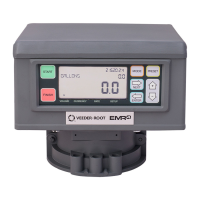EMR4 Troubleshooting Guide System Error Codes
65
System Error Codes
E20 - RELAY FAILURE OR E50 - IB COMM FAILURE
Serial communication from the IB Box is not working.
• Check the wiring at both the Display Head and the IB, make sure wire A goes to terminal A and B goes to B
etc. Also, one end of the cable shield, or drain wire, must be tied to chassis ground using the appropriate saddle
clamp hardware.
• In some EMR4 Systems, adding a suppression diode across each dc powered flow control solenoid valve will
be required to avoid IB COM FAILURES. See the appropriate DC Solenoid Wiring figures located in the EMR4
Application Guide, Veeder-Root P/N 577014-339.
• Flow-Control Solenoid valves are one source of electrical noise. See the External Sources of System Noise
located in Appendix C of this manual for further explanation.
(EMR4 Systems with Dual Heads)
• If the E20 RELAY FAILURE or E50 IB COMM FAILURE continues, try swapping the Display Head 1 wiring with
the Display Head 2 wiring. If the problem follows the Display Head, replace it, if not, test the IB board with a
known good Display Head. A faulty IB circuit board can also be the cause an E20/E50 IB COMM FAILURE.
• When two display heads are operating from a single IB, an E50 IB COM FAILURE will occur if both heads have
the same Head Address. Put the Display Head in Set-up Mode and go to the System Address menu to check
the address number for each display head. Cycle the power to EMR4 system to clear the error message once
an address change is made.
• In a two display head configuration, if Display Head 1 has a failure, Display Head 2 may also display an E50 IB
COM FAILURE. See the Dual Head Set-up information located in Appendix A of this manual.
IB INDICATOR LIGHTS AND IB SELF CHECKS
The tri-color LED, located inside the Interconnect Box, is capable of indicating 4 different states: Green, Red,
Yellow and Off (see Figure 54). At start up, the LED flashes the initialization sequence of Off-Green-Red-Yellow-
Off indicating that the IB self-test passed with no errors to display. If one or more Display Heads are
communicating with the IB the LED will flash an Off-Green-Off pattern repeatedly. If one or more IB Relay is active,
or a delivery is in process, the LED will flash an Off-Yellow-Off sequence until all the relays are inactive.
If a communication error occurs, the LED will flash Off-Red-Off indicating a problem. Try swapping the Display
Heads as described above in order to locate the problem. The LED will not indicate a non-functional Display Head.
If a self-test error occurs, the LED will flash an Off-Red-Off-Red-Off sequence indicating a problem. Try swapping
the IB with another IB in order to locate the problem.
If the LED is stuck in one of the 4 states, remove input power from the input terminals for a few seconds. Restore
power and check the LED for the Off-Green-Red-Yellow-Off sequence. If the LED fails to flash in the proper
sequence, replace the IB Circuit Board.

